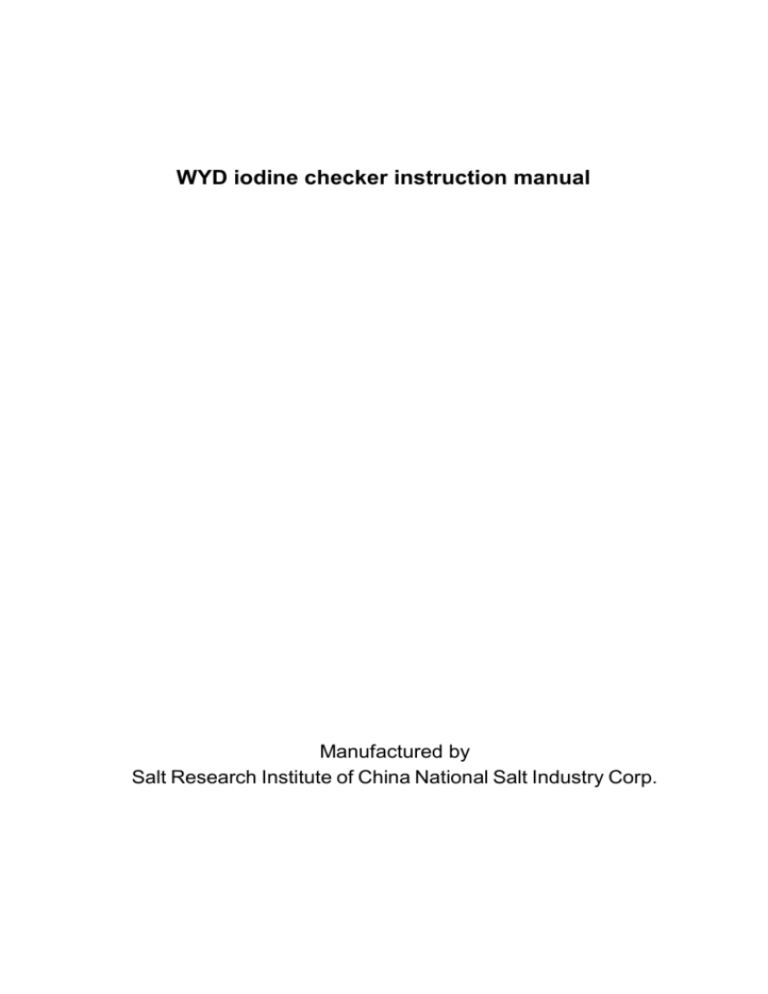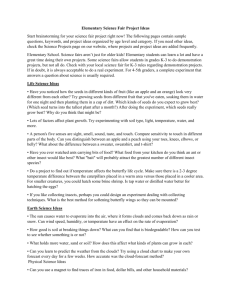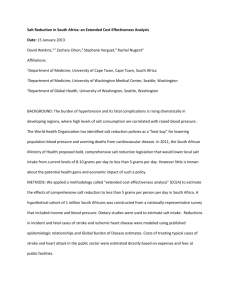Salt Iodine WYD Iodine Checker Instruction Manual
advertisement

WYD iodine checker instruction manual Manufactured by Salt Research Institute of China National Salt Industry Corp. Content page 1. Configuration of the WYD 2. Operation principle 3. Specifications 4. Standard Content 5. Operation Procedures 6. Maintenance 7. Troubleshooting 8. Service 2 3 4 4 4 4 6 6 Appendix 1: Quick measuring iodine concentration in iodized salt by using WYD iodine checker Appendix 2: Taking a sample 1 12 WYD iodine checker is a simple single wavelength spectrophotometer with the functions of LCD readout, zero autocalibration, concentration readout. The WYD can resist damp and corrosive environment. A calibrated gray glass provided in the WYD is worked as a standard instead of standard solution, and makes the WYD to be used easily. The WYD is designed for measurement of iodine in iodized salt, and it can be applied into the field of iodized salt production, sales, and as well as prevention and cure of endemic. The result is reliable compared to the result measured by traditional titration method. 1. Configuration of the WYD (see Figure 1) Figure 1. Configuration of the WYD 1. LCD Readout 2. Zero Autocalibration 3. Calibration Key 4. Sample Cell Chamber 5. AC Power Receptacle 6. DC Power Receptacle (6 AA 2 batteries) 2. Operation principle WYD is a special instrument for measurement of iodine in iodized salt, it was designed according to the absorbing characteristics of iodine-starch blue compound at 585nm and Bill equation. First, insert the reference, when the single wavelength light eradiated by the optical system passes the reference solution and reach to the detector, the concentration of iodine is adjusted to zero by pressing zero autocalibration key, then insert sample, since the light which reach to the detector is reduced due to the absorbance of the sample, according to Bill equation, the reduced light intensity is positively related to the iodine concentration of the sample. The optical signal caught by the detector is converted into an electrical signal, and then sent to the DC amplifier. The amplified signal further log-converted signal indicates an iodine concentration. After the WYD is calibrated by a known standard sample, then insert unknown sample, the concentration can be read out on the LCD directly. 3. Specifications Stability Measuring range Accuracy Repeatability drift < 0.3 in10 min. 10~90mg/kg analytical error < 2ppm fluctuation <2% (at 3 the concentration of 50 mg/kg) Dimensions 175x135x60mm Weight 500g Power requirement AC 220V or DC 9V 4. Standard Content WYD main body 1 Cell (1 cm) 2 Battery holder Gray glass (0.7A) 1 Glass Tube (50 mL) Plastic Bottle (100 mL) Instruction manual in English Inspection sheet in English 1 2 2 1 1 5. Operation Procedures See detail in‘Measurement of iodine concentration in iodized salt by using WYD iodine checker’ 6. Maintenance Install the WYD in the dry place with good ventilation and avoid corrective environment. Clean the salt and dust on instrument after use. If the WYD is located in damp environment for long period, its stability would be reduced and the drifts would become big, in this case it is necessary to prolong warm-up time. 1) The water used in this method Distill water, Purified drink water, Cool boiling water 4 2) The calibration of the gray glass Gray glass has a stable absorbance within long period, it is convenient to be used as a standard for the calibration of the WYD instead of the solution standard. However, the absorbance of the grey glass is affected by the sensitivity of the starch solution, storage time and temperature (season changes). To reduce the systematic error, the gray glass needs to be calibrated regularly. 3) Cell maintenance To get reliable and accurate results and to avoid contamination of the instrument, the cells must be kept clean. Dirt cell may contaminate the cell holder and the gray glass, causing analytical error. Inside of the cell can be cleaned by a bar brush, outside of the cell can be cleaned by a filter paper. To avoid rust of the instrument, clean the cell holder, gray and its frame regularly. 5 7. Troubleshooting Symptom 1. No signal reading on LCD Cause Power cable disconnected 2. The digital reading fluctuates much Too short warm-up time Too high vibration 3. The digital reading drifts much 4. No digital reading responded when sample is inserted into the holder. low power voltage (when DC power is supplied) The instrument is blocked 8. Service Guarantee: 1 year. 6 Remedy Check and connect the power cable. Warm-up instrument Select proper place Replace battery Press or V key. If the problem still exists, disconnect the power cable and reconnect it. Appendix 1: Quick measuring iodine concentration in iodized salt by using WYD iodine checker Application WYD is suitable for the measurement of iodine concentration in KIO3 and I- type iodized salt. Abstract Weigh 1.0 gram of iodized salt in 50ml tube, and add 10ml of distill water, 2ml of KI-starch solution and 2ml of H3PO4(1+3),shaking the tube until the salt was dissolved in the solution thoroughly, then add distill water to make 50ml and shake the tube evenly. Insert the cell which contains this solution in the cell holder of the WYD, the concentration is directly read out on LCD. (when measuring iodized salt contains I-, first, I- needs to be oxidized by excess bromine solution, then the excess bromine was neutralized by sodium formate.). The result is comparable with that obtained by using titration method. 1. Principle KI can be oxidized to I2 by KIO3 in the sample under acidic condition and blue iodine-starch compound is formed in the solution, the concentration (mg/kg) of iodine was directly read out on the LCD of WYD iodine checker. 7 8 2. Chemicals 2.1. KIO3 standard solution (1000g I-/ml) Weigh 0.8432g KIO3 which was dried at 100-110℃for 3 hours and dissolve this in 500ml distill water. 2.2. Iodine working standard solution (10g/ml - 20% NaCl) Take 5.0ml KIO3 standard solution and add 100g NaCl and 0.5g Na2CO3, add distill water to make 500ml, and shake the solution thoroughly. This solution can be used within 6 months. 5.0 ml of solution equals the concentration of 50mg/kg in the iodized salt sample. 2.3. KI-Starch solution (A) Weigh 2.0 g soluble starch, add distill water and stir thoroughly, transfer this into 200ml boiling water and boil it for 2 minutes, after cooling, add 1.0g KI and 40g K2HPO4.3H2O, this solution can be stored in a bottle for 3 months. 2.4. H2SO4 (1mol/L) (B): Mix 11ml H2SO4 with 190ml distilled water evenly. 2.5. 3% (w/v) Bromine solution 2.6. Sodium formate (100g/l) Dissolve 10g sodium formate in 100ml distill water. 3. Instrument 1) WYD iodine checker (Distributed by Salt Research 9 Institute of China National Council of Light Industry) 2) Balance (0.1g) 3) 50ml tubes, 5ml and 10ml pipette 4. Procedures 4.1. Prepare standard solution for calibration of the iodine checker or gray glass Transfer 5.0ml iodine working standard solution (10g/ml) into 50ml tube, add 2 ml KI-Starch solution (A) and 2ml H2SO4 (B), mix the solution evenly, and add distill water to make 50 ml, shake the tube thoroughly, measure this solution, this solution equals concentration of 50mg I-/kg salt. 4.2.Prepare sample solution Weigh 1.0g well-mixed iodized salt in 50ml tube, add 10ml distill water, 2 ml KI-Starch solution (A) and 2ml H2SO4 (B), then follow the same procedure in 4.1. 4.3. Measurement on WYD iodine checker 1 point calibration is used in the WYD. Firstly zero point of this instrument is calibrated by distill water. Secondly, span calibration is performed by a standard solution (or gray glass). Finally the sample solution is measured on WYD, its concentration is directly readout on the LCD of the WYD. 4.3.1 The keypad on the WYD (see Figure 1) 1. LCD Readout 2. Zero Autocalibration 3. Calibration Key 4. Sample Cell Chamber 10 4.3.2. Calibrating the WYD and gray glass, measuring the sample Calibration 1) Turn on the power of WYD and warm-up it for 10 minutes (prolong warm-up time if WYD has not been used for long period). 2) Insert the cell which contains distill water into the cell holder (the optical path from right to left), close the lid of the sample compartment, press autocalibration key, 0.0 appears on the readout LCD. 3) Insert the cell which contains standard solution (4.1), close the lid of the sample compartment, set 500.1 on the readout LCD with or V key. 4). Insert gray glass, read out and write down the value, using gray glass for later calibration of the WYD is more convenient and easier than using standard solution. Measuring Insert the sample solution, the concentration (mg I-/kg) of iodine is directly readout on the WYD. 6. Discussion 6.1. Mixing the sample evenly The size homogeneity of the iodized salt affect the accuracy of the measurement, the sample must be mixed thoroughly before weighing, (stirring dry and well dispersed fine salt by a fork, yet stirring moist 11 sample by a small kitchen mixer or chopsticks), the results on the analysis of iodized salt from different region (sea salt, lake salt, well salt and mine salt) and different type salt indicates that taking 1.0g (0.05g) of sample for the analysis is reliable, when salt sample has good size homogeneity. For the sample without homogeneous size, weigh 10.0g of the sample and make 50 ml solution, take 5.0ml of this solution for analysis. 6.2. Oxidization of IPrevious experiments show that the iodine concentration in sea salt, lake salt and mine salt contains KIO3 can be directly measured. Since some iodized salt produced by well brine of Sichuan province China contains I- and other deoxidized matter, they have to be oxidized first, 3% bromine solution is selected due to the following advantages: fast reaction, good result, easy removing of the excess bromine. The concentration of the bromine can be reduced along with storage time (several months). 6.3. Oxidization procedures Weigh 1.0g salt sample in 50ml tube, dissolve it in about 10 ml distill water, add bromine solution until light yellow appears, shake the tube evenly and add 0.5 ml sodium formate solution (100g/l), close the tube well, shake the tube and make the bromine 12 vapor be absorbed thoroughly, allow the solution to stand for 1-2 minutes, then follow the procedures in 4.1 to measure the concentration. The pre-oxidization is not needed for the low sodium iodized salt, and some nutrient enriched iodized salt, such as, Zinc, Selenium, Lactoflavin iodized salt, except for calcium enriched iodized salt, the procedure of the oxidization for calcium enriched iodized salt follow the procedures: Weigh 1.0g calcium enriched iodized salt in 50ml tube, dissolve it in 10 ml distill water and 0.5ml 1mol/l HCl, add bromine solution in the tube, then add sodium formate to remove excess bromine. Appendix 2: Taking a sample For the iodized salt with homogeneous size, the sample is taken by a spoon (volume 1 cm3). Since the granule size of the iodized salt varies with different kinds of iodized salt, the weight of salt in a spoon needs to be calibrated by dividing the weight of 5 spoons of salt into 5 (each spoon of salt is kept flat) before sampling. The concentration (mg/kg) of the iodine is obtained by dividing the digital reading with the weight of a spoon of salt. 13 Salt Research Institute, China National Salt Industry Corp. 831 Ying Kou Road, Tanggu, Tianjin, PR China Tel: 86-22-65271739 Fax: 86-22-25851450 Email: salt-cen@starinfo.net.cn 14









